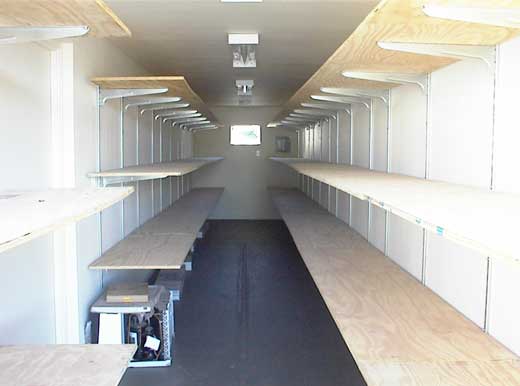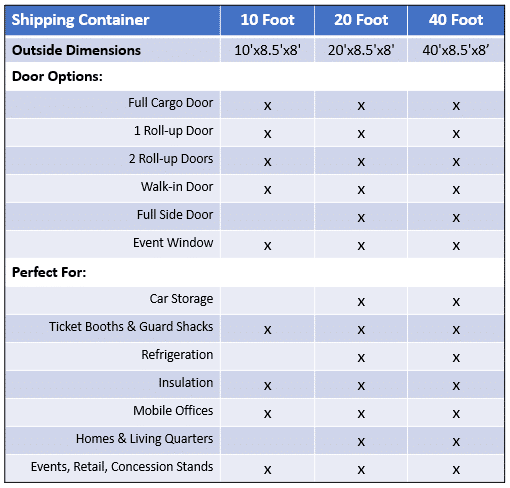The Cost-Saving Benefits of Insulated Shipping Containers
If you’re looking for insulated shipping containers for sale that offer superior protection and significant cost savings, you’ve come to the right place.
- Durability: Built to last from corten steel.
- Temperature Control: Keeps contents at stable temperatures.
- Cost-Effective: Used containers offer great value.
- Versatility: Suitable for various applications like storage and transportation.
Insulated shipping containers are a smart investment for small to medium-sized business owners and construction managers. Whether you need to store temperature-sensitive goods, or create a durable on-site workspace, these containers offer reliable and flexible solutions. By choosing a used insulated shipping container, you also gain the financial benefit of lower upfront costs, without compromising on quality or performance.
I’m Steve Hyndman, Vice President of Aztec Container. With over 30 years of experience, I’ve guided many clients in selecting the best insulated shipping containers for sale to meet their needs. Let’s dig into why these containers are a fantastic choice for your business.
Insulated shipping containers for sale word list:
– how much does an insulated shipping container cost
– how to insulate shipping containers
– shipping container floor insulation
Why Choose Insulated Shipping Containers?
Insulated shipping containers offer a range of benefits that make them a great choice for many businesses. Let’s explore the key advantages: temperature control, moisture protection, and versatile usage.
Temperature Control
One of the biggest perks of insulated shipping containers is their ability to maintain a stable internal temperature. This is crucial if you’re storing or transporting temperature-sensitive items like pharmaceuticals, food, or electronics.
Fact: Our 40ft insulated containers are built with 3 inches of closed-cell spray foam, providing unbeatable protection from extreme temperatures.
Using these containers means you won’t need to worry about your goods getting too hot in the summer or freezing in the winter. This makes them ideal for businesses that need reliable temperature control without the high costs of dedicated refrigeration units.
Moisture Protection
Moisture is a common enemy when storing valuable items. Insulated shipping containers are designed to keep moisture out, ensuring that your goods remain dry and safe.
Example: EX reefers, known for their robust construction, are excellent at handling moisture and water, making them a reliable choice for hard usage.
Moisture protection is especially important if you’re storing items prone to damage from humidity, like paper products, textiles, or electronics. The seamless molded EPS foam used in these containers provides an additional layer of moisture resistance.
Versatile Usage
Insulated shipping containers are incredibly versatile. They can be used for a wide range of applications, from storage and transportation to being converted into functional spaces.
Case Study: A ski lodge used insulated shipping containers as stylishly utilitarian cabins, providing a warm and cozy environment even in extreme winter conditions.
You can also use these containers for:
- Pop-up stores: Easily set up and dismantle.
- On-site offices: Create a comfortable workspace on construction sites.
- Living quarters: Convert into temporary or permanent housing solutions.
The adaptability of insulated shipping containers makes them a valuable asset for any business looking for flexible, cost-effective solutions.
Real-World Examples
- Art Storage: Protect valuable artworks from temperature fluctuations and moisture.
- Food Transportation: Keep perishable goods fresh over long distances.
- Temporary Shelters: Provide immediate housing solutions in disaster-stricken areas.
Quote: “A shipping container is just a sturdy box, and that’s all it really is. With a few tweaks, it can be anything that you need it to be.”
By choosing insulated shipping containers for sale, you’re investing in a reliable, versatile, and cost-effective solution for your business needs.
Next, let’s explore the different types of insulated shipping containers available. From 20-foot to 40-foot options, we’ll help you find the perfect fit for your needs.
Types of Insulated Shipping Containers
When it comes to insulated shipping containers, you have several options to choose from. Each type serves different needs, and we’ll break them down for you here. Whether you’re storing, transporting, or converting these containers, understanding the types available will help you make the best decision.
20-Foot Containers
20-foot insulated containers are a popular choice for those needing a compact yet efficient storage solution.
- Dimensions: Typically 20 feet in length, 8 feet in width, and 8 feet 6 inches in height.
- Usage: Ideal for storing items that require temperature stability, such as food, pharmaceuticals, and electronics.
- Advantages: Their smaller size makes them easier to transport and place, especially in tight spaces.
Example: A small bakery used a 20-foot insulated container to store ingredients that needed to stay cool, ensuring product quality and reducing waste.
40-Foot Containers
40-foot insulated containers offer more space and are perfect for larger storage needs.
- Dimensions: 40 feet in length, 8 feet in width, and 8 feet 6 inches in height.
- Usage: Suitable for bulk storage or transportation of goods that need temperature control.
- Advantages: More room means you can store larger quantities or bigger items, making it cost-effective for bulk storage.
Fact: Aztec Container’s 40-foot insulated containers have a robust construction, including 8′ gauge steel frames and 14′ gauge steel bodies, ensuring durability and security.
High-Cube Containers
High-cube containers provide an additional foot of height, making them about 9 feet 6 inches tall. This extra space can be crucial for certain storage and transportation needs.
- Dimensions: 40 feet in length, 8 feet in width, and 9 feet 6 inches in height.
- Usage: Ideal for storing taller items or goods that need to be stacked higher.
- Advantages: The increased volume offers more storage space without a significant increase in footprint.
Example: A furniture company used high-cube containers to store bulky items like sofas and wardrobes, taking advantage of the extra height to maximize storage efficiency.
Real-World Applications
- Food Storage: Both 20-foot and 40-foot containers are excellent for keeping perishable goods fresh.
- Construction Sites: High-cube containers serve as temporary offices or storage for large equipment.
- Emergency Relief: Insulated containers can be quickly deployed as temporary shelters, offering a stable environment in disaster areas.
Quote: “High-cube containers are lifesavers for our business. The extra height allows us to store more without needing additional containers,” says a satisfied customer from a logistics company.
By understanding the different types of insulated shipping containers for sale, you can select the one that best fits your needs, ensuring efficient and cost-effective storage or transportation solutions.
Next, let’s dive into the cost factors of insulated shipping containers and what you can expect when making a purchase.
Insulated Shipping Containers for Sale
Looking to save big on insulated shipping containers for sale? You’ve come to the right place. Whether you’re in the market for a new unit or a used one, understanding your options can help you make a smart investment.
New vs. Used
New Containers:
– Pristine Condition: New containers are free from wear and tear, ensuring maximum durability and longevity.
– Higher Cost: Expect to pay a premium for new units, but the investment can be worth it for long-term use.
Used Containers:
– Cost-Effective: Used containers are more affordable, making them a popular choice for budget-conscious buyers.
– Inspect Carefully: Always check for rust, dents, and structural integrity. Ensure they are still watertight and secure.
Case Study: A local farm saved 30% by opting for a used 40-foot insulated container to store its harvest. Regular maintenance kept it in top shape for over a decade.
Customization Options
Insulated shipping containers are versatile and can be customized to meet your specific needs:
1. Insulation Types:
– Spray Foam: Expands to fill gaps, offering excellent temperature control.
– Pink Batt Insulation: Adds extra thermal protection when combined with spray foam.
2. Windows and Doors:
– Sliding Glass Windows: Perfect for creating a cozy living or office space.
– Fixed Windows: Ideal for storage or workshops.
– Custom Doors: From standard double-swing doors to more specialized options like roll-up doors.
3. Flooring:
– Thermal Treated Aluminum: Durable and prevents condensation buildup, suitable for heavy-duty use like driving forklifts.
Example: A construction company customized a high-cube container with extra windows and reinforced flooring to use as an on-site office, significantly enhancing its functionality.
Real-World Applications
Food Storage:
– Keep perishable goods fresh with reliable temperature control.
Construction Sites:
– Use as temporary offices or storage for large equipment.
Emergency Relief:
– Deploy as temporary shelters, offering a stable environment in disaster areas.
Quote: “High-cube containers are lifesavers for our business. The extra height allows us to store more without needing additional containers,” says a satisfied customer from a logistics company.
By choosing the right type of insulated shipping container, whether new or used, and customizing it to fit your specific needs, you can achieve efficient and cost-effective solutions for storage and transportation.
Next, let’s dive into the cost factors of insulated shipping containers and what you can expect when making a purchase.
Cost of Insulated Shipping Containers
When considering the cost of insulated shipping containers, several factors play a role. Here’s what you need to know to make an informed decision.
Price Range
New Containers:
– Starting Price: Around $3,000 for a 20-foot container.
– 40-foot Containers: Prices can go up to $6,000.
Used Containers:
– Starting Price: Approximately $2,475 for a 20-foot container.
– 40-foot Containers: Generally cheaper than new ones, but prices vary based on condition.
Factors Affecting Cost
1. Condition and Age:
– New Containers: More expensive but in pristine condition.
– Used Containers: Cheaper but may have wear and tear. Always inspect for rust, dents, and structural integrity.
2. Modifications:
– Basic Modifications: Adding windows, doors, or insulation can add a few thousand dollars.
– Extensive Modifications: Plumbing, electrical installations, and specialized customizations can significantly raise the price.
3. Delivery and Setup:
– Local Delivery: Starts at $350 but can vary based on location and accessibility.
– Chassis Delivery: Cost-effective but requires organizing a crane for offloading.
– On Ground Delivery: More expensive but includes container drop-off using a truck’s own equipment.
Example: A construction company opted for on-ground delivery for their high-cube container office, ensuring it was placed precisely where needed without additional hassle.
Cost Comparison
Buying vs. Renting:
| Option | Cost | Best For |
|---|---|---|
| Buying | $2,475 – $6,000+ | Long-term use, customizable needs |
| Renting | $75 – $200 per month | Short-term projects, temporary storage |
Pro Tip: Always compare quotes from different suppliers and check for hidden fees to get the best deal.
Case Study: A local farm saved 30% by opting for a used 40-foot insulated container to store its harvest. Regular maintenance kept it in top shape for over a decade.
Financial Lease
If the upfront cost is too high, consider a financial lease. This option allows for staggered payments, making it easier to manage your budget.
Requirements:
– Minimum Order: At least 500€.
– European VAT ID: Required for lease plan service.
Benefits:
– Fast Handling Times: Quick delivery with little capital investment.
– Affordable Payments: Spread the cost over time.
By understanding these cost factors, you can choose the best option that fits your budget and needs. Whether buying or renting, insulated shipping containers offer versatile and cost-effective solutions for various applications.
Next, let’s explore how to insulate a shipping container cheaply and effectively.
How to Insulate a Shipping Container Cheaply
Looking to insulate a shipping container without breaking the bank? You’re in the right place! Here are some cost-effective methods to keep your container warm in winter and cool in summer.
Fiberglass Insulation
Fiberglass is one of the most affordable and effective insulation materials available.
- Cost-Effective: Fiberglass insulation is relatively cheap compared to other options.
- Easy to Install: You can easily cut fiberglass batts to fit the walls, ceiling, and floor of your container.
- Thermal Efficiency: It provides excellent thermal insulation, keeping your container at a stable temperature.
Pro Tip: Wear protective gear when handling fiberglass to avoid irritation.
DIY Installation
Doing it yourself can save you a lot of money. Here’s a simple step-by-step guide:
- Measure and Cut: Measure the dimensions of your container and cut the fiberglass batts accordingly.
- Install a Vapor Barrier: Place a vapor barrier on the interior walls to prevent moisture buildup.
- Fit the Insulation: Place the fiberglass batts snugly between the metal studs of the container.
- Seal the Edges: Use spray foam or caulk to seal any gaps or edges to prevent air leaks.
- Cover with Plywood: For added protection and aesthetics, cover the insulated walls with plywood or drywall.
Materials Needed:
– Fiberglass batts
– Vapor barrier
– Spray foam or caulk
– Plywood or drywall
– Protective gear (gloves, mask, goggles)
Cost-Effective Methods
Besides fiberglass, there are other affordable ways to insulate your container.
- Reflective Foil: Use reflective foil insulation to reflect heat away from your container. It’s easy to install and works well in hot climates.
- Recycled Materials: Consider using recycled insulation materials like denim or cellulose. These are not only cost-effective but also eco-friendly.
- Spray Foam: While slightly more expensive, closed-cell spray foam provides excellent insulation and acts as a moisture barrier. A thin layer can be used in combination with other materials to save costs.
Case Study: A small business owner used a combination of fiberglass batts and reflective foil to insulate a 20-foot container. The total cost was under $500, and the container stayed comfortable year-round.
By using these methods, you can insulate your shipping container cheaply and effectively. Up next, we’ll answer some frequently asked questions about insulated shipping containers.
Frequently Asked Questions about Insulated Shipping Containers
How to cheaply insulate a shipping container?
Fiberglass Insulation is a popular, cost-effective option for insulating shipping containers. Here’s why:
- Affordable: Fiberglass batts are cheaper than many other insulation materials.
- Easy Installation: You can cut and fit them yourself, making it a great DIY project.
- Thermal Efficiency: Keeps your container at a stable temperature.
DIY Methods can save even more money. Here’s a quick guide:
- Measure and Cut: Measure your container’s dimensions and cut the fiberglass batts to fit.
- Install a Vapor Barrier: This prevents moisture buildup.
- Fit the Insulation: Place the fiberglass batts between the metal studs.
- Seal the Edges: Use spray foam or caulk to seal gaps.
- Cover with Plywood: For a finished look and added protection.
Pro Tip: Always wear protective gear when handling fiberglass to avoid skin irritation.
Other Cost-Effective Methods include:
- Reflective Foil: Reflects heat away, great for hot climates.
- Recycled Materials: Use eco-friendly options like denim or cellulose.
- Spray Foam: Closed-cell spray foam provides excellent insulation and moisture control. Use a thin layer to save costs.
How much does it cost to insulate a 20-foot shipping container?
The cost to insulate a 20-foot shipping container can vary widely based on the materials used and whether you DIY or hire professionals.
- Fiberglass Insulation: Typically costs between $0.40 to $0.50 per square foot. For a 20-foot container, expect to spend around $300–$500.
- InSoFast Packages: These are specialized insulation panels for shipping containers. Costs can range from $1,200 to $2,000 for a 20-foot container, but they offer quick installation and excellent thermal performance.
- Spray Foam: More expensive, ranging from $1.00 to $2.00 per square foot. Total costs can be $800–$1,600.
Case Study: A small business owner used a mix of fiberglass batts and reflective foil, spending under $500 to insulate a 20-foot container, keeping it comfortable year-round.
What size are insulated shipping containers?
Insulated shipping containers come in several standard sizes:
- 20-Foot Containers: Dimensions are 20′ x 8′ x 8.6′. They offer about 160 square feet of space. Ideal for small projects or limited storage needs.
- 40-Foot Containers: Dimensions are 40′ x 8′ x 8.6′. These provide double the space of a 20-foot container, making them suitable for larger storage or more complex projects.
- High-Cube Containers: Available in both 20-foot and 40-foot lengths, but with an extra foot of height (9.6′ tall). Perfect for storing taller items or creating more spacious living areas.
By understanding these sizes, you can choose the right insulated shipping container for your needs, whether it’s for storage, a workspace, or even a tiny home.
Conclusion
At Aztec Container, we pride ourselves on providing top-notch insulated shipping containers for sale that cater to your unique needs.
Competitive Prices
We offer competitive prices without compromising on quality. Whether you’re looking for a new or used container, we ensure you get the best value for your money. Our flexible pricing options allow you to choose a solution that fits your budget, making it easier to find the perfect container for your needs.
Fast Delivery
We understand that time is crucial. That’s why we guarantee fast delivery to your location. Our streamlined processes and extensive inventory mean you won’t have to wait long. We handle all logistics, ensuring a hassle-free experience from start to finish.
Customizable Solutions
Every customer has unique requirements, and we’re here to meet them. Our containers can be fully customized to suit your specific needs. Whether you need additional windows, doors, or specialized insulation, we can modify your container to fit your exact specifications.
For more information and to explore our selection of shipping containers, visit our 20-foot insulated container page.
Thank you for considering Aztec Container for your shipping container needs. We look forward to serving you!







